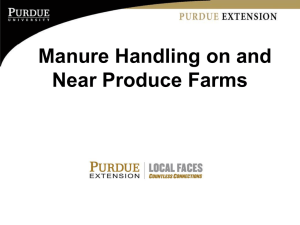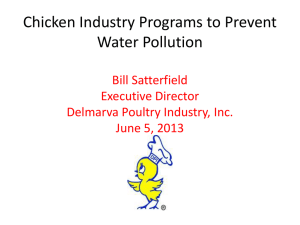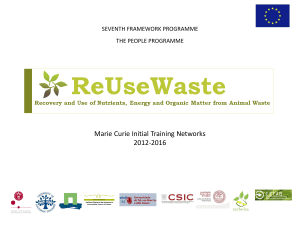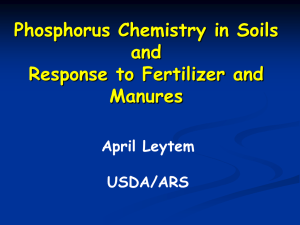Reducing dependence on Chemical fertilizers and its Financial
advertisement
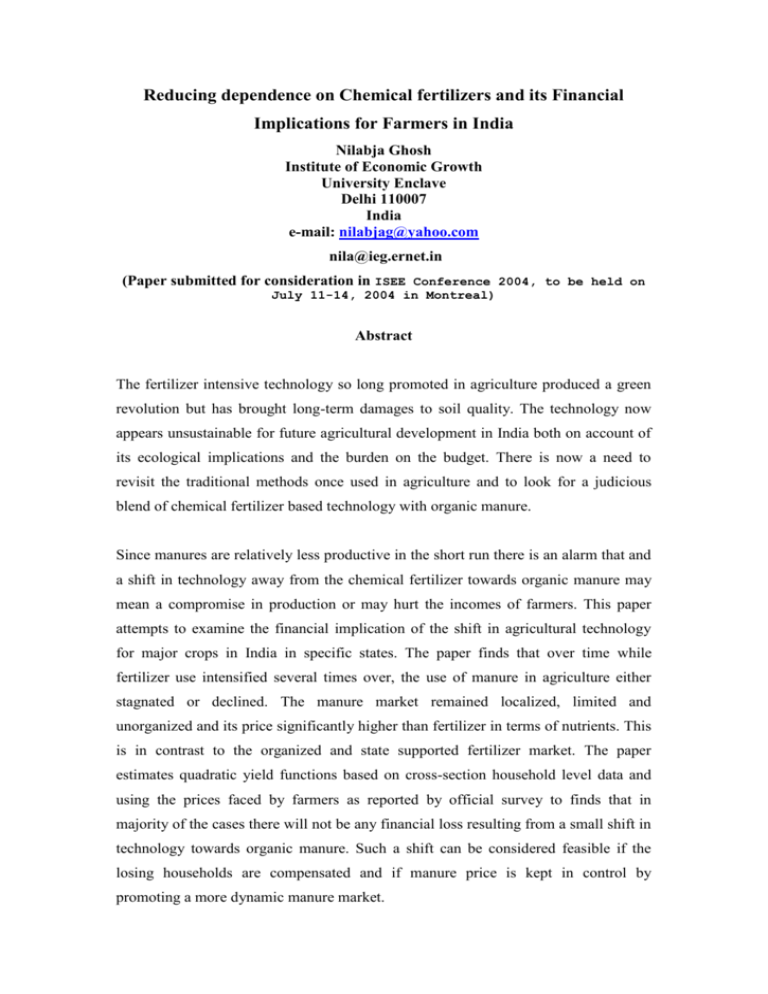
Reducing dependence on Chemical fertilizers and its Financial
Implications for Farmers in India
Nilabja Ghosh
Institute of Economic Growth
University Enclave
Delhi 110007
India
e-mail: nilabjag@yahoo.com
nila@ieg.ernet.in
(Paper submitted for consideration in ISEE Conference 2004, to be held on
July 11-14, 2004 in Montreal)
Abstract
The fertilizer intensive technology so long promoted in agriculture produced a green
revolution but has brought long-term damages to soil quality. The technology now
appears unsustainable for future agricultural development in India both on account of
its ecological implications and the burden on the budget. There is now a need to
revisit the traditional methods once used in agriculture and to look for a judicious
blend of chemical fertilizer based technology with organic manure.
Since manures are relatively less productive in the short run there is an alarm that and
a shift in technology away from the chemical fertilizer towards organic manure may
mean a compromise in production or may hurt the incomes of farmers. This paper
attempts to examine the financial implication of the shift in agricultural technology
for major crops in India in specific states. The paper finds that over time while
fertilizer use intensified several times over, the use of manure in agriculture either
stagnated or declined. The manure market remained localized, limited and
unorganized and its price significantly higher than fertilizer in terms of nutrients. This
is in contrast to the organized and state supported fertilizer market. The paper
estimates quadratic yield functions based on cross-section household level data and
using the prices faced by farmers as reported by official survey to finds that in
majority of the cases there will not be any financial loss resulting from a small shift in
technology towards organic manure. Such a shift can be considered feasible if the
losing households are compensated and if manure price is kept in control by
promoting a more dynamic manure market.
Theme: Uncertainty and the precautionary principle
Reducing dependence on Chemical fertilizers and its Financial Implications for
Farmers in India
Nilabja Ghosh
Institute of Economic Growth
University Enclave
Delhi 110007
India
e-mail: nilabjag@yahoo.com
nila@ieg.ernet.in
Introduction
It is increasingly being realized that the intensive use of chemical fertilizers, so long promoted for
higher productivity in agriculture, is harmful for soil and proves counter productive in the long run.
Prolonged use of the chemical based technology in Indian agriculture has undermined soil quality in
terms of its physical, biological and chemical properties afflicting its ability to satisfy healthy plant
growth and crop production. Continuous nutrient mining with use of fertilizer leaves the soil hungrier
with an ever-increasing gap between depletion and replenishment and proves unsustainable. Further,
the dependence of Indian agriculture on chemical fertilizer for high crop yields implies a basic reliance
on exhaustible fossil fuels with chances of pollution at the production stage. There is also the adverse
possibility of nitrogen leaching into ground water leading to possible health hazards through pollution
of both surface and ground water resources. The subsidy backed price policy for fertilizers has often
been blamed for indiscriminate and irrational use but the correction of domestic price distortions is not
the remedy to the environmental threat, as market prices and increased competition of the free trade
regime could also intensify resource use in the search for higher productivity from soil. Besides,
withdrawal of subsidies and exposure to global competition inevitable in the present context could deal
a setback on production and income of farmers in the absence of an alternative technology in hand.
Traditionally Indian agriculture had been driven by indigenous knowledge based methods and locally
re-generable materials for soil fertilization making up an organic technology. The advent of the modern
technology based on HYV seeds and chemical fertilizers and challenge of shortages that was a reality
in the 1960s impelled a turn from traditional to modern technology in agriculture that ran its course
through the decades. Today, in the wake of changing perceptions and approaches on market and
ecology there is a need to revisit the traditions and work for a judicious mix of the modern and
traditional technologies for greater sustainability of development. Since chemical fertilizers impart
greater productivity than manures that constitute bulk of the organic technology, the shift in input mix
towards organic methods raises some alarm with respect to its impact on returns to farmers.
This paper considers one major cereal paddy and one cash crop groundnut in India and is devoted to
study the tendencies observed in Indian agriculture and the implication of a reversal towards a more
sustainable technology for farm incomes suggesting possible precautions. The issues considered are (1)
the technological changes in Indian agriculture with respect to use of manures and fertilizers, (2) the
issues arising in the manure and fertilizer markets and (3) financial implications of the shift towards
organic manure to the farmers. The analysis is based on sample data provided by the official survey of
the government of India “Cost of cultivation (COC) of principal crops’.
Fertilizer use Practices in India and changing Circumstances
During the first half of the twentieth century chemicals were used only in pocket of commercial
plantations of cash crops in India. Traditional agriculture based on indigenous and natural inputs took a
sharp bend in the 1960s and in the quest for food-security India accepted the new agrarian technology
offered at that time by scientific advancements for adoption on Indian soil. Fertilizer was the crucial
input in the package essential for the success of the new seeds and demanding irrigation facility for its
uptake.
Table 1: Fertilizer Use in India (NPK)
Period
Production
Consumption
Import
Triennium Average
('000tonnes)
('000tonnes)
('000tonnes)
1976/77-78/79
2653.8
4271.2
1519.2
1981/82-83/84
4354.0
6721.3
1509.6
1986/87-88/89
7723.3
9489.8
1624.6
1991/92-93/94
9573.3
12416.3
2968.0
1996/97-98/99
12668.4
15764.5
2917.3
1999-2000
14320.9
18068.8
4163.9
2000-01
14676.9
16702.3
2179.4
Source: Fertilizer Statistics
Cons/Ha.
(Kg/Ha.)
24.8
38.1
53.7
67.2
83.2
93.8
86.7
The government promoted farm level adoption of fertilizer use practice by not only financial support,
but through active campaigns and demonstrations and inviting private and commercial initiative to
build up a vibrant market linked with the cooperative and credit sectors for agricultural development.
During the period 1950-51 to 2001-02 production of foodgrains increased due to the impressive rise in
yield levels brought about by the modern inputs, most prominently chemical fertilizers. But perhaps
along way, the merits of traditional methods lost some of their shine and the consequences of that loss
became visible when the economic system once again changed, this time from a controlled to a market
oriented one and the green revolution started running out of steam. It is becoming clear that agriculture
cannot bank on intensive fertilizer use for future development.
Several shortcomings of the fertilizer-based technology were becoming apparent since the eighties
(Vaidyanathan, 1989). Despite all promotion, fertilizer use intensity remained low relative to
aspirations. Consumption remained mostly confined to irrigated regions with rainfed areas that are
predestined to dominate Indian agriculture getting a meagre share of 20% of fertilizer consumed in the
country. The hill regions hardly responded. The limitations of the state machinery, poverty of farmers
as well as the agronomic and social realities all served to restrain the dissemination of the green
revolution. The inefficiency of fertilizer use also became a concern when increasing use of valuable
fertilizer did not result in expected gains in yield. Non-proportional and indiscriminate use relative to
agronomic needs reported in some parts of the country raised questions on sustainability of agriculture.
Concerns about nutrient imbalances and soil deficiencies related to NPK, sulphur, zinc and
molybdenum are widespread. Too much reliance on chemicals led to depletion of soil organic contents
not only undermining the quality of soil but also limiting the potentials of chemical fertilizer. Nitrate
pollution of ground water as per WHO’s minimum norm of 10mg/litre is threatening to become a
reality in pockets of high fertilizer use with water samples exceeding the permissible limits reported in
specific cases. Finally, to make fertilizer cheap and affordable to farmers increasing cost burden has
weighed down on the union budget. It is increasingly becoming apparent that further growth in
agriculture can be expected from the excessively fertilizer demanding technology only at the peril of
higher cost, dwindling returns, worsening of rural poverty and greater ecological threats in terms of
long term productivity and pollution of water and air. Awareness on food contamination has been
growing too on consumers’ part and the call for a change in technology also comes from the emerging
market for food with minimal chemical residue. There is now a case for revisiting the cleaner
traditional technology to draw support for the modern one.
Organic manures
Organic soil fertilizers can be derived from various vegetal and animal wastes. The most commonly
used organic fertilizer is the farmyard manure (FYM) in which cattle dung constitutes the major
component. FYM is generally home produced and its quality is highly variable depending on the
quality and proportion of the vegetal and animal waste matter it incorporates and the process of
decomposition. Inadequate facilities and pre-sowing time constraint often result in use of inefficient
and under-decomposed manure compromising on the productivity effect. Manure is however traded in
rural India across farm households in a market small in size and heavily determined by local
informational, agronomic, domestic and seasonal factors.
It appears that although Indian farmers and policy makers have appreciated the merits of manure use,
the extent of use has shown little dynamism over the years. Published data based on Ministry of
Agriculture’s periodic survey on cost of cultivation (COC) of principal crops show that for paddy while
fertilizer use per hectare has steadily grown through the last three decades, corresponding manure
(FYM) use has been rather stable and in fact declined in Andhra Pradesh and Uttar Pradesh (Table 2).
The growth rates on a point-to-point basis is small even if positive, in contrast to fertilizer use which
grew by more than 200% in each case. Groundnut shows similar trends.
Table 2 : Changes in fertilizer and manure use over time: Paddy and Groundnut
Paddy
Andhra
Pradesh
Orissa
Groundnut
Punjab
Uttar
Pradesh
West
Bengal
Andhra
Pradesh
Orissa
Gujarat
Fertilizer nutrients (Kg/Hect)
1970s
53.2
10.0
124.0
28.5
10.7
17.6
16.6
16.1
1980s
126.8
13.8
180.8
45.0
31.8
26.3
23.0
50.3
1990s
176.8
61.2
182.6
89.1
69.9
44.3
47.0
57.6
Manure use (Qtl./Hect.)
1970s
58.1
26.7
25.7
19.8
27.3
40.9
15.8
36.0
1980s
67.5
26.3
56.9
26.4
48.5
33.6
16.3
36.3
1990s
38.0
28.6
40.0
9.0
29.3
26.6
20.3
28.6
232
509
47
212
551
152
183
257
Growth rate %
Fertilizer
Manure
-34
7
56
-54
7
-35
31
-21
Note: Computed with COC Data taking averages of first triennium for 1970s and 1980s and last
triennium for 1990s for which data is available. Biennium is considered when sufficient
data is not reported.
The COC sample data for 1998-99 averaged over select states and crops only and summarized in Table
3 indicate that manure price expressed in terms of the major nutrients is not less than 4 times that of
fertilizer. Groundnut comes low in respect of fertilizer use intensity but leads when manure use in
considered.
Table 3 : Statistics on Use of Fertilizer and Manure based on selected
States sample: 1998-99
Crops
Unit
Paddy
Groundnut
Manure use intensity
Qtl./Hectare
18.9
22.3
Manure Price(Bulk)
Rs/Qtl.
16. 6
21.2
Fertilizer use intensity
Kg/Hectare
116.5
63.6
Fertilizer Price (NPK)
Rs/Kg
10.9
12.6
Price ratio (M/F)
%
422.0
465.2
Note: Price ratio is based on manure conversion: 1tonne bulk equiv. 3.6
Kg nutrients (NPK). Sample states and crops: Paddy- Andhra Pradesh,
Tamil Nadu, Kerala, Bihar, West Bengal, Assam, Uttar Pradesh,
Punjab and Madhya Pradesh. Wheat- Bihar, Gujarat, Himachal
Pradesh, Punjab, Rajasthan, Uttar Pradesh. Groundnut- Andhra Pradesh
Karnataka, Tamil Nadu, Gujarat, Maharashtra, Orissa. SugarcaneAndhra Pradesh Tamil Nadu, Maharashtra, Uttar Pradesh. Sample area
under crops are used as weights. Source:COC.
Implications of a Shift in Fertilizer – Manure Mix
Since fertilizer has been a prime source of productivity in Indian agriculture, a move away from
fertilizer towards organic manure raises serious uncertainty about its effect on output and income
security of farmers and any policy towards such a shift needs to be taken with due consideration and
caution. The availability of detailed (COC) data giving physical quantities of inputs used, makes it
possible to estimate yield response functions that help address some important questions that follow (1)
What would be the yield loss if farmers were to apply less fertilizer than they do currently? (2) Can
chemical fertilizer be technically substituted by manure under existing conditions and does their
conjunctive use improve each other’s effectiveness? (c) If that is possible, since manures are costly, are
their financial returns protected by the same substitution? This study is based on cross-section farm
household level information for the most recent year for 1998-99 and will attempt to estimate yield
functions of paddy and groundnut for dominant states for which the data is provided.
From a priori understanding of production technology, the two inputs serve important functions in soil
enrichment that are supplementary as well as complementary in character. Both are dominant sources
of soil nutrients although manure, the traditional input, is bulky and less intensive or specific in nutrient
contents compared to chemical based water-soluble fertilizers, which however have greater tendency to
leach out leaving the soil hungrier for nutrients. At the same time manure has important soil enriching
properties that enables chemical fertilizer, when applied, to be more effective and efficient when the
soil is rendered more porous, aerated and biologically active. The existence of the dual relation of
substitution and synergy makes the choices on input mix more complex as also significant in
determining the loss or gain from cultivation in both physical and financial terms. Conditioned by soilclimatic characteristics and the price situations prevailing, the implications of changing inputs mixes
are likely to vary by the crops cultivated, by regions and also across households with some sections
gaining at the same time that others lose out.
The data used in this paper relate to the following cases:
Sample states and crops
Paddy: Andhra Pradesh, Tamil Nadu, Kerala, Bihar, West Bengal, Assam, Uttar Pradesh, Punjab and
Madhya Pradesh.
Groundnut: Andhra Pradesh, Karnataka, Tamil Nadu, Gujarat, Maharashtra, Orissa.
Only those households are selected for the present analyses, which have undertaken cultivation of the
concerned crop in the year 1998-99. This paper considers costi to include opportunity cost of own
resources including family labour so that negative returns are a possibility when production is not
commercially profitable. Fertilizer is a purchased input while manure can be either purchased or
owned. Purchased inputs are valued by the actual cost (‘out of pocket expenses’) incurred but in
considering owned or ‘farm produced manure’ (which presumably is collected from own household
wastes, farm droppings or from common lands) ‘prevailing rates in the villages’ are used for evaluation
assuming they reflect to an extent the non-monetary cost of collection in terms of family members’
time. The survey demarcates each state into homogeneous agro-climatic zones based on cropping
pattern, soil type, rainfall.
Econometric Issues
(a) The simple quadratic form is chosen to describe the yield function (Desai, 1979) in the present
case for the following advantages: (a) Simplicity, (b) Flexibility and (c) Suitable properties ii.
Interaction term between fertilizer and manure allow for technical substitution or complementarity
along an iso-output curve (see technical note 1) and interaction with self through a squared term. In
cases where input application is not high in context of the situation, the negative quadratic effect may
not be there.
The general form of the yield function is as follows:
YLD = a0 + a1 FRT + a2 MANU + a12 (FRT*MANU) + a11 (FRT*FRT)
a22 (MANU*MANU) + a3 LAB + a4 IRR +Σa5i DUM-Zi ……. (1)
Where dependent variable is
YLD =Yield rate (Quintals/Hectare)
And independent variables are
(1)
FRT =Fertilizer (Kilograms/hectare)
(2)
MANU=Manure (Quintals per hectare)
(3)
LAB= Labour (hours per hectare)
(4)
IRR=Dummy variable for irrigation
(5)
DUM-Zi = Dumy variable for i-th Zone
To allow for agro-climatic and institutional differences, the yield functions are estimated separately for
different states and dummies are used for agro-climatic zones within a state.
DUMMY-Zi = 1 if the household belongs to zone i
=0 otherwise, i=1,2, n-1
where there are n zones in a state-crop combination and the nth zone is the base.
Fertiliser variable is nutrients (N P K) in Kg. per hectare of area and the variable is treated as a
composite of all three nutrients. Manure is used as physical bulk in quintals per hectare. Irrigation data
is available in physical terms and in that situation a simple binary quantification of the irrigated status
has been attempted and since in certain states access to adequate and timely water supply is intimately
related to the kind of water resources available (for instance, where ground water reserves are poor,
expenditure on well irrigation may not mean the same as access to government canals) differentiation
of irrigation is attempted in terms of canal water and pumped (other forms) water. Three possible
specifications in terms of irrigation status are defined as below where irrigation charges refer to hired
or owned or canal facility.
The following irrigation variables are employed in alternative specifications:
Irrigation specification 1: IRG = 1 if Irrigation charges>0
=0 otherwise.
Irrigation specification 2: IRCNL= 1 if canal charges paid>0
=0 otherwise.
Irrigation specification 3: IRPUM=1 if cost of owned irrigation>0 or cost of hired irrigation>0
=0 otherwise.
Labour input can induce variations in yield levels of crops, given all other inputs. With modernization
of agriculture, machine labour also gained prominence and can be an important replacement for human
labouriii. Human labour and machine labour denoted by HLAB and MLAB are considered alternatively
in the specifications and machine labour is considered as a second choice in the specification only
when its use improves the estimate of the equation. The weather effect, though extremely important in
agriculture, has not been included as it is necessarily spatial in expanse and is not expected to vary
significantly across farm units in any region or even appreciably within any state. It is pertinent to note
that 1998-99 experienced a normal monsoon and the production performance in agriculture was
satisfactoryiv. Before undertaking the regression exercises the simple correlation between variables are
examined as a possible check for multicollinearity and specifications in which any pair of variables are
found to be linked by a correlation coefficient of 50% or above are ruled out.
Estimates from Yield Functions
The regression equations estimated after correcting for heteroscedasticity are reported in Appendix
Tables 1 and 2. The coefficients are then used for calculation of marginal products (and elasticities)
that are further utilized for calculating returns at prevailing and hypothetical prices.
For fertilizer the coefficient denoting the pure effect (considering the cross effect and quadratic effect
as absent) is usually positive and also statistically significant. Assam and Madhya Pradesh for paddy
are exceptions in which cases the effect is insignificant and negative but manure use is found to have
positive effects. For groundnut only Maharashtra is found to show positive and significant signs for
manure. The squared term appears with a negative sign in more cases for fertilizer than manure but is
not always significant. The labour variable mostly appears with a positive and significant coefficient.
Machine labour has been preferred in the specification in two cases of paddy and one case for
groundnut. The irrigation effect is mostly found positive for paddy but is insignificant in most cases for
groundnut reflecting the fact that groundnut has lower requirement of water than many crops. A
positive interaction dominates between fertilizer and manure given by the coefficients of the cross term
and its significance level in each equation.
The marginal products (MPs) would depend on the parameters as well as the input levels prevailing at
the household level (notes 2) and corresponding elasticities are derived to measure the responses of
yield rates to input use. These are comprehensive measures of responses taking into account the pure
effects, the quadratic effects and the interactions at the given level of input use. Reported in Tables 4
the elasticities are generally low and lower for manure than fertilizer. The elasticity with respect to
fertilizer use is generally positive but negative elasticity is found for paddy in Madhya Pradesh where
farms using higher intensities of fertilizer show no superiority in terms of higher yield rates.
Though it may be technically possible to substitute manure to an extent for the intrinsically scarce and
eco-damaging chemical fertilizer, this may not be economically acceptable to farmers if the shift in
technology undermines the returns from cultivation by way of increased cost. The outcome depends on
the relative prices of the two sources of nutrients as faced by the individual farmer. Certainly, such a
switch is not feasible if a large section of households suffer losses on its account. The approach taken
in this paper is to examine the implication of an extensive move towards a less fertilizer intensive and
more manure intensive technology and to simulate cases in which a certain small cut in fertilizer input
is substituted by manure use so as to maintain the yield rates at existing levels and then work out the
changes in returns. The change is computed at the household level at the given input use levels and
prices faced by the household. The results are of course completely sensitive to the initial and existing
resource use configuration of the households due to the very nature of yield function considered.
Though the function is nonlinear with respect to the input variables, computation of substitutability and
hence the changes in returns call for a linearization over small changes in fertilizer use. The method
used is given in more detail in the Appendix notes. In the absence of a clear policy constraint or
separate projection the present approach is to consider an arbitrary and small proportional change, a 1%
cut in fertilizer intensity. The farmer is considered to reduce the fertilizer input per hectare and then
substitute it by greater (or less of) manure input by an amount, which keeps the yield level unchanged
going by the estimated yield function. The new level of returns per hectare described as Scenario2
along with the change over the base level is noted and the average returns and gains of the households
are computed. An intermediate situation where the cut in fertilizer use reflects on yield level and is not
replaced by manure is described as Scenario1. Since the impact of the shift can vary across households,
not less important than the average impact is the distribution of gains or losses across households. An
estimate of the percentage of households that draw financial gain and that suffer losses from the switch
in technology is therefore useful for assessing the change. A further break down of the distribution of
the level of financial gains or losses over the base situation is attempted for appraising the depth of the
impact.
Gain large: Gain =Rs. 1000.00 and above.
Gain moderate: Gain =Rs. 10.00 and above but less than Rs. 1000.00.
No gain/loss: Gain = -Rs. 10.00 and above but less than Rs. 10.00.
Loss moderate: Gain = -Rs. 1000 and above but less than -Rs.10.00.
Loss severe: Gain = less than -Rs. 1000.00.
It is evident that the first two categories for which estimated returns work out to be not less than Rs.
10.00 represent the gainers while the last two categories with loss more than Rs 10.00 are the losers.
An intermediate category making small gain or loss (of Rs. 10.00 or less) is considered not
significantly affected by the change.
In all cases the calculations are based on area weighted averages across households. The elasticities
with respect to the inputs are obtained by applying the mean levels of marginal products to the mean
yield and input levels.
Results
The results of this exercise (Table 4) give diverse implications depending on the signs of the
elasticities. In some of the cases manure use produces negative effect on yield at the margin implying
there is actually an associated reduction in manure use required to counter any adverse effect of the cut
in fertilizer use. For paddy in Madhya Pradesh both inputs are found to come with negative elasticities
at existing input use levels. Taking into account the net impacts on mean returns and the elasticities
some idea can be formed on the desirability of the shift. In most cases there is little perceptible decline
in mean returns in Scenario 1. Scenario 2 incorporates a movement towards manure so long as the
elasticity is greater than zero. The shift is viewed as financially feasible if gains improve. The returns
improve on the average from the adjustment in most cases.
For paddy the southern states do not appear to gain from a shift towards manure at prevailing prices but
Assam, Bihar, Punjab and Uttar Pradesh gain. In Madhya Pradesh there is a need to look at the soil
quality, cropping pattern and other ways of soil enrichment to identify the paradox arising out of a
negative impact of fertilizer use. The shift is found helpful for groundnut. There appears considerable
variation in returns across households though a large portion of farmers is not affected significantly.
The percentage of gainers generally outweighs that of losers.
Table4(a) : Change in Returns due to Substitution of 1% Fertilizer use by Manure;Yield unchanged: Paddy
Mean Elasticity Mean
of Yield
Return
Manur
Fertilizer e
Base
Rs/hect.
(R1)
Mean
Return
Mean
Return
Loss from Gain from
Unaffected
by
Scenario1 Scenario2 Change
change
change
Rs/hect.(R Rs/hect.(R %househol
%househol
4)
5)
d
%household d
Paddy
Andhra
Pradesh
0.115
0.011 4152
4151
4138
28.4
57.6
14.0
Assam
0.004
0.027 2475
2475
2476
0.0
0.2
99.8
Tamil Nadu
0.139
-0.014 6225
6218
6376
1.4
97.6
1.0
Madhya
Pradesh
-0.017
-0.007 645
652
663
11.9
18.9
69.2
Kerala
0.217
0.017 4295
4257
4232
62.5
23.0
14.5
Bihar
0.147
0.001 2217
2212
2224
0.6
21.3
78.1
Punjab
0.214
0.021 3417
3393
3432
0.8
77.5
21.7
West Bengal
0.241
0.038 3182
3153
3109
32.3
34.6
33.1
Uttar Pradesh 0.068
0.008 1788
1799
1800
0.2
45.4
54.4
Notes :Scenario 1: Cut in Fertilizer use and no substitution, Scenario 2: With substitution;
The Gain/Loss are calculated with respect to Scenario 2. Elasticities are at mean values of input use.
Table4(b) : Change in Returns due to Substitution of 1% Fertilizer use by Manure; Yield unchanged:
Groundnut
Mean Elasticity of Mean
Mean
Mean
Unaffected
Yield
Return
Return
Return
Loss from Gain from
by
Fertilizer Manure Base
Scenario1 Scenario2 Change
change
change
Rs/hect.(R Rs/hect.(R Rs/hect.(R %househol
%househol
1)
3)
4)
d
%household d
Groundnut
Andhra
Pradesh
0.183
0.005 471
467
525
33.5
24.2
42.3
Maharashtra 0.350
0.065 1597
1546
1604
5.0
33.8
61.2
Kanataka
0.188
0.003 -746
-753
-983
58.6
13.5
27.9
Gujarat
0.074
0.056 7762
7761
7766
15.3
22.6
62.1
Orissa
0.221
-0.035 1926
1912
1934
1.4
33.8
64.8
Tamil Nadu
0.147
-0.038 4120
4125
4131
10.9
53.6
35.5
Manure Price and Gains from Shift
The calculation of the gains has been made under a supposition of unchanged prices. In the cases where
the cut in fertilizer use is compensated by an increase in manure, given that the market for manure is
constrained, localized and marked by inelasticties, there is considerable chance that manure price will
be sensitive to the increased demand at the aggregate or household level. The calculation of gains on
the basis of elastic supply is therefore an underestimate. The cross-section data also does not help in
computing elasticities with any reliable estimates. In the absence of the estimated price responses of
manure from existing literature one can set certain limits within which the broad results can be
validated. The gains calculated at prevailing prices would diminish as manure price responds to
increased use and the gains can be sustained with the technological substitution only up to a point at
which it is wiped out. Since revenue is unchanged with substitution (yield level is maintained),
sustenance of gains requires that the savings achieved from reducing fertilizer use be not surpassed by
the additional cost of manure use even if manure price rises alongside. The limit price of manure at
which the gains reach value of zero is expressed as a ratio to the actual prevailing price paid by the
household to find the scope of increase admissible for the substitution (see notes 2). The averages of
the ratios (LIM-Pm) is presented in Table 5 for the cases in which reduction in fertilizer use is
compensated by increased manure us. The margin within which manure price can move up is low
generally falling within a small margin of the prevailing price though this is higher for paddy in Bihar
leaving some room for adjustment. The ratios fall below 1.0 in cases where loss is already indicated
and the substitution can only be feasible if manure price falls.
Table 5: Maximum of Manure price to Prevailing price Ratio (LIM-Pm) : Sample
averages
Paddy
State
Andhra
Pradesh
Assam
Bihar
Ratio
0.76
1.01
5.54
Kerala
0.87
Punjab
1.04
Groundnut
State
Andhra
Pradesh
Gujarat
Karna
Taka
Mahar
ashtra
Ratio
0.61
1.01
0.69
1.00
Uttar Pradesh
1.01
West
0.94
Bengal
Note: Presented only for cases in which manure use increases and marginal products
are positive
Concluding Points
In view of sustainability problems associated with the chemical intensive way to agricultural
development there is a case to revisit traditional wisdom and work for a judicious blend of modern and
traditional technology in agriculture. A shift in technology away from highly chemical based practices
to organic manure use can be an answer but the productivity effect of the shift has called for caution
about the likely impact on farmers’ incomes.
With the advent of the high yielding technology in India, agriculture has moved away from the practice
of using manure for soil enrichment and in this vital input seems to have been neglected while fertilizer
use showed dynamics. Fertilizer market was greatly promoted by the government as well as
commercial enterprise but rural manure market remained limited, unorganised and local. This paper
examines the effect on farm returns of a small shift in technology towards manure use keeping
productivity unchanged through estimated yield functions for paddy and groundnut. These in general
corroborate the superior productivity effect of fertilizer use in the short term though there are instances
of inefficiency and over-use. The interactions between the two vary but a synergic effect dominates.
But substitution of organic manure for chemical fertilizers is possible and simulations suggest that the
shift on the whole may not hurt income in most cases. However since the effect differs by households
and depends on the response of manure price to increased use, the shift can be practicable if losing
households are protected by policy and by promoting a more dynamic manure market to control
manure prices. Higher premiums on output prices if possible in a market for a product embodying a
more sustainable technology could be another way in which farm incomes can be protected.
APPENDIX
Technical Notes
1. Interactions
Where the interaction is positive (negative) as indicated by parameter a12, higher amount of any one
input would increase (reduce) the marginal product of the other.
MPF= d(YLD)/d(FRT) =a1 + a12 MANU + 2a11FRT………(2)
MPM= d(YLD)/d(MANU) =a2 + a12 FRT + 2a22MANU……(3)
The negative second derivatives a11 and a22 imply that higher amount of any input would diminish its
own marginal productivity. While a12 depicts the interaction between fertilizer and manure in terms of
each one’s effect on the other’s marginal productivity, the marginal rate of technical substitution
MRS= [ d(YLD)/d(FRT) ]/ [d(YLD)/d(MANU) ]…………(4)
provides a measure of the amount by which manure use has to adjust following a unit change in
fertilizer amount such that the yield rate is maintained.
2. Calculation of Returns
The returns from cultivation at base level is total revenue (R) less total cost (C2) at given household
level prices expressed as
C2=Pf FRT + Pm MANU + OC2 ….1(A)
R = P X YLD….2(A)
Here Pf and PM are prices of fertilizer and manure and P is crop prices, OC2 is all other cost combined
as reported and returns at base level R1 is given by
R1 = R – C2……….. 3(A)
It is supposed that each household reduces its fertilizer use uniformly by 1%. The change in fertilizer
use and the revised returns R2 are then given by
ΔFRT= -FRT (1-0.01)……4(A)
R2= R – C22……….5(A)
Where C22 = C2+ Pf ΔFRT reflecting only the reduced cost of fertilizer use presuming that the yield is
unaffected by the cut. Now the yield function can be applied to measure the yield impact as product of
marginal product of fertilizer times the change in fertilizer use giving the yield adjusted returns:
ΔYLD= MPF X ΔFRT………6(A)
R3= (R+P(ΔYLD)) –C22…….7(A)
R3 reflects the complete effect of the cut coming through cost and yield adjustment. What we are
interested is the impact when the cut is made good by adjusting manure use so keep yield and hence the
revenue levels unchanged. The change in manure use is dictated by the substitutability
ΔMANU= MRS X ΔFRT…….8(A)
MRS = MPF/MPM…..9(A)
We then have the final returns level R4
R4= R – C23…..10(A)
Where C23 = C2+ Pf ΔFRT + PM ΔMANU……..11(A)
Note that in the final analysis the yield and revenue are same as the base level but the cost is changed
by adjustment in both fertilizer and manure use levels. Also the MPF, MPM and hence the MRS are
computed at the initial level that is the base level in this case. In Tables 4 Returns R1, R3 and R4 are
reported as scenarios base, 1 and 2 respectively.
When manure price increases with greater use of manure the returns will diminish and attain value of
zero at the limit. This is when the savings in the cost of fertilizer use is just balanced by the increased
manure cost at the increased manure price (PM max).
Pf ΔFRT = PM max(Manu +ΔMANU) - PM MANU
PM max= ( Pf ΔFRT + PM MANU)/( Manu +ΔMANU)
LIM-Pm= PM max/ PM
i
This is known as concept C2= Cost to owner farmer including rental value of owned land, rent paid
for leased in land and and imputed value of family labour.
ii
The advantages are:
(a) Simplicity: The function can be linearised in parameters after suitable transformation of variables
and the parameters can be suitably interpreted.
(b) Flexibility: The function is sufficiently flexible in that (i) it allows for positive or negative
interactions between variables, (ii) it allows the marginal effects of inputs to vary (unlike linear
functions) and even change signs and (c) It makes no restrictive assumptions such as constant marginal
products, constant returns to scale or constant elasticity of substitution.
Suitable Properties: It allows for usual expected properties of agricultural yield functions as per theory
and economic reality, and also allows for zero valued variables since the variables are not essential in
nature.
iii
Machine labour, predominantly as tractor, is used for ploughing and is logically expected to
substitute for human labour. Empirical evidence to this effect have been provided by Krishna1975,
Chopra, 1995, Agarwal,1983).
iv
The monsoon which has a dominant influence on agricultural performance in both kharif and rabi
seasons, was more than satisfactory in 1998 with only 2 of the meteoroglogical sub-divisions recording
‘scanty’ rainfall, 81% of districts in the country enjoying normal or excess rainfall and the rainfall level
of the country measuring 106% of the long period average rainfall (Economic Survey,2002).
Appendix Table A1 : Estimated Parameters of Yield Equations: Paddy
Variables
CONSTANT
FERTILISER
MANURE
FERTILISER*
MANURE
FERTILISERSQUARED
MANURESQUARED
HUMANLABOUR
Andhra
Pradesh
26.49
(6.16)
0.091
(2.03)
-0.017
(-.498)
0.0002
(1.61)
-0.0002
(-1.795)
-0.00012
(-.983)
0.00005
(0.499)
Assam
Bihar
Kerala
14.04
(12.05)
-0.02
(-.44)
0.106
(1.56)
0.01
(1.868)
9.87
(9.7)
0.083
(4.78)
0.022
(0.45)
0.0002
(0.847)
-0.00025
(-3.14)
-0.001
(-1.69)
0.008
(8.03)
29.86
(18.17)
0.079
(3.51)
0.087
(2.39)
-0.0004
(-1.13)
-0.00004
(-.48)
0.006
(3.32)
ZONEDUMMY2
ZONEDUMMY3
ZONEDUMMY4
ZONEDUMMY5
ZONEDUMMY6
ZONEDUMMY7
ZONEDUMMY8
ZONEDUMMY9
11.9
(7.42)
-0.0006
(-0.05)
0.016
(0.433)
-0.0006
(-1.04)
0.0005
(.31)
0.190
(2.28)
MACHINELABOUR
IRRIGATION
Madhya
Pradesh
1.725
(2.053)
12.32
(9.01)
7.91
(4.25)
9.85
(6.59)
13.53
(8.59)
3.12
(1.75)
5.79
(8.75)
16.67
(9.19)
8.95
(9.26)
7.63
(8.38)
0.46
(0.83)
-2.56
(-3.94)
8.65
(11.56)
-5.51
(-5.72)
-2.38
(-4.94)
-2.71
(-5.46)
2.89
(1.60)
-11.19
(-6.61)
-4.08
(-2.17)
1.63
(2.22)
1.11
(0.61)
2.93
(1.64)
-3.32
(-1.58)
-3.44
(-2.08)
0.35
(0.20)
4.62
(2.98)
8.82
(5.11)
Punjab
Tamil
Nadu
Uttar
Pradesh
West
Bengal
11.32
28.99
14.31
11.37
(2.12)
(7.13)
(8.79)
(7.20)
0.175
0.132
0.072
0.124
(3.67)
(3.36)
(1.86)
(7.32)
0.073
-0.06
0.046
-0.018
(1.53)
(-2.76)
(2.88)
(-0.77)
-0.0002
0.0003 -0.00008 0.0006
(-.77)
(2.68)
(-0.67)
(5.67)
-0.0003 -0.00029 -0.0002 -0.0003
(-3.27)
(-2.76)
(-1.32)
(4.437)
-0.00003
-0.00015
(-2.46)
(-2.07)
0.0009
0.003
0.006
(.836)
(1.92)
(5.08)
0.139
(3.86)
9.56
(2.80)
0.59
(0.26)
1.19
(0.52)
0.147
(0.14)
1.91
(1.29)
3.74
(1.97)
1.71
(1.14)
9.41
(5.98)
6.42
(3.32)
3.36
(3.58)
8.54
(4.27)
14.12
(7.1)
10.76
(5.53)
9.27
(3.19)
-6.84
(-3.87)
9.13
(4.90)
2.69
(1.42)
3.67
(2.27)
5.00
(5.52)
5.93
(4.35)
3.61
(3.48)
4.52
(4.22)
5.79
(5.05)
RBAR0.30
0.40
0.68
0.48
0.43
0.14
0.19
0.26
0.54
SQUARED
17.69
38.98
87.55
31.7
15.9
5.31
9.9
13.5
62.9
F-Statistic
422
449
534
269
237
240
417
489
591
Sample
Irrigation
IRCNL
IRG
IRCNL
IRG
IRG
IRG
IRCNL IRPUM
IRG
Specification
Note: Figures in parentheses are t-statistics. Specifications for irrigation are IRG=irrigation by any source, IRCL= irrigation
by canal, IRPUM=irrigation using pumped water.
Appendix Table A2: Estimated Parameters of Yield Equations: Groundnut
Variables
CONSTANT
FERTILISER
MANURE
FERTILISER*
MANURE
FERTILISERSQUARED
Andhra
Pradesh
5.29
(4.02)
0.063
(2.98)
-0.001
(-.06)
0.00007
(.34)
-0.0002
(-2.71)
MANURESQUARED
HUMANLABOUR
0.0068
(6.57)
Gujarat
5.71
(2.93)
0.032
(1.62)
0.009
(.479)
0.0003
(2.61)
-0.0002
(-1.94)
-0.0001
(-1.25)
0.008
(5.32)
Karn
ataka
Mahara
Shtra
5.62
(3.62)
0.036
(1.93
0.002
(.19)
-0.00001
(-.089)
-0.0001
(-1.17)
8.26
(6.04)
0.075
(8.84)
0.101
(2.71)
-0.0008
(-3.34)
ZONEDUMMY2
ZONEDUMMY3
ZONEDUMMY4
ZONEDUMMY5
4.48
(8.04)
-4.84
(-3.36)
0.474
(.33)
-7.32
(-4.37)
-10.29
(-5.46)
8.76
(4.00)
2.534
-2.13
-1.33
(-1.54)
2.88
(2.27)
1.85
(1.91)
-0.67
(-.62)
0.124
(.084)
0.38
9.38
137
0.56
25.6
235
0.26
4.46
111
IRCNL
IRG
IRPUM
ZONEDUMMY7
ZONEDUMMY8
ZONEDUMMY9
RBAR-SQUARED
F-Statistic
Sample
Irrigation
Specification
Note: See Table A1
8.59
(7.19)
0.072
(3.15)
-0.039
(-1.49)
.00007
(.166)
-0.0003
(-1.89)
21.39
(12.00)
0.042
(2.60)
-0.038
(-1.45)
0.0002
(1.61)
-0.0012
(-1.76)
0.0003
(.317)
-0.54
(-.68)
-8.97
(-4.31)
-1.42
(-1.13)
-1.79
(-1.07)
-2.3
(-1.07)
ZONEDUMMY6
Tamil
Nadu
-0.0003
(-1.13)
MACHINELABOUR
IRRIGATION
Orissa
-0.21
(-0.16))
-5.57
(-4.04)
-1.35
(-.80)
1.53
(1.29)
-4.95
(-1.99)
-0.67
(-1.18)
-1.72
(-1.14)
10.44
(7.97)
-5.60
(-3.67)
0.44
5.77
80
IRG
0.37
(2.58)
0.26
(0.28)
-0.57
(-.49)
-1.38
(-1.73)
-1.55
(-1.76)
0.53
9.93
71
IRG
-5.45
(-2.87)
-10.91
(-3.81)
-8.38
(-4.21)
-7.01
(-4.28)
-5.92
(-3.13)
0.19
3.86
110
IRG
References
Anderson Kym and Anna Strutt (1996) On Measuring the Environmental Impact of Agricultural Trade
Liberalization in Bredahl et al (ed) Agriculture, Trade & the Environment, Westview Press.
Agarwal,B (1983) Mechanisation in Indian Agriculture: An Analytical Study based on Punjab, Allied
Publishers Pvt. Ltd.
Bliss, C.J. and N.H. Stern (1982) Palanpur, The Economy of an Indian Village, Oxford University
Press, Delhi.
Chopra Kanchan (1985) “Substitution and Complementarity Between Inputs in Paddy Cultivation”,
Journal of Quantitative Economics, Vol.1 No.2 July.
Desai, M. (1979) Applied Econometrics, Tata Macgraw Hill.
Fertilizer Association of India (various), Fertilizer Statistics.
Ghosh Nilabja (1998) Studies of Supply Responses in Indian Agriculture, Ph.D. dissertation submitted
to Indian Statistical Institute.
Ghosh Nilabja (2003) “Impact of Trade Liberalization on Returns from Land: A Regional Study of
Indian Agriculture”, Discussion paper at WIDER, United Nations University, Helsinki, 2002.
Government of India (1991, 1996, 2000) Comprehensive Scheme for Studying the Cost of Cultivation
of Principle Crops in India, Department of Agriculture and Cooperation, Ministry of Agriculture, New
Delhi.
Government of India Agricultural Statistics at a Glance, Department of Economics and Statistics,
Mininstry of Agriculture, New Delhi (various).
Gulati Ashok (1989) “Input Subsidies in Indian Agriculture”, Economic and Political Weekly, June 24.
Krishna, R. (1975) “Measurement of the Direct and and Indirect Employment effects of Agricultural
growth in Technical change”, in Edgar O. Edwards (ed) Employment in Developing Nations, Columbia
University Press.
Narayana N.S.S. and K.S, Parikh (1987), “Estimation of Yield Functions of Major Cereals in India”,
Journal of Quantitative Economics Vol.3, No.2.
Vaidyanathan A., (1989) Fertilisers in Indian Agriculture, L. S. Venkataraman Memorial lecture,
Institute of Social and Economic Change, Bangalore.


